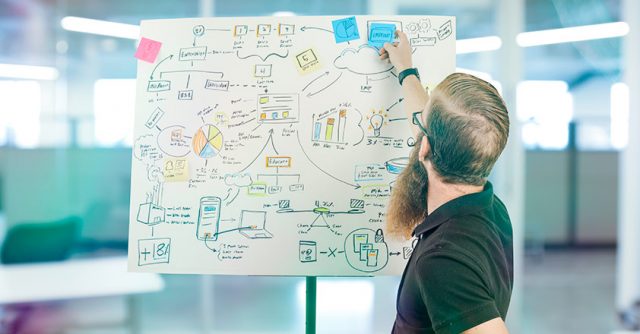In the modern digital era, software development has become a critical factor that helps businesses maintain and thrive on the path of commerce. In this blog post, let’s explore software development costs and delve into effective software outsourcing strategies with TechLead.
Deciphering software development costs
1. Factors affecting software outsourcing costs
In the ever-evolving landscape of software development, understanding the intricate interplay of factors influencing project costs is essential for organizations striving to maintain competitiveness and maximize return on investment. As software projects continue to grow in scale and complexity, the need for nuanced cost analysis becomes increasingly pronounced. From the initial scoping phase to post-implementation maintenance, every facet of a project’s life cycle is permeated by considerations of cost.
- Project Scope

Project Scope (Collected)
The magnitude of a software development project can have profound implications on its associated costs. Larger projects often necessitate a more substantial allocation of resources, encompassing not only manpower but also infrastructure and equipment requirements. Additionally, the sheer scale of large projects introduces a higher probability of encountering intricate challenges, thereby amplifying both operational and maintenance costs over the project’s lifecycle. Understanding and effectively managing the project scope is paramount in navigating these complexities and ensuring cost efficiency.
- Complexity of Requirements
The complexity and expansiveness of project requirements represent pivotal factors shaping the trajectory of software development costs. Projects with intricate and extensive requirements pose formidable challenges, demanding a heightened investment of time and resources for their successful completion. Establishing a comprehensive understanding of requirements and implementing robust management practices are indispensable in minimizing risks and curbing superfluous expenditures throughout the project life cycle.
-
Nature of the Product

Nature of the Product (Collected)
The nature of the software product itself exerts a substantial influence on overall costs. For example, software solutions necessitating integration with pre-existing systems typically entail higher expenditures compared to the development of standalone applications. Moreover, the inherent complexity of the software, encompassing elements such as stringent security protocols and demanding performance standards, can significantly augment both development and testing expenses.
-
Platforms and Technologies
The adoption of novel and sophisticated platforms and technologies can exert upward pressure on project costs owing to the requisite expertise and experience needed to navigate these technological frontiers. Furthermore, the selection of a specific platform can have enduring ramifications on operational and maintenance expenditures, emphasizing the criticality of making informed decisions in this regard.
-
Human Resources

Human Resources (Collected)
The caliber and availability of human resources represent pivotal determinants of software development costs. Skilled technical personnel command commensurately higher remuneration, thereby constituting a substantial portion of overall project expenses. Additionally, the stability of the development team is paramount, as personnel turnover can introduce inefficiencies and escalate costs while potentially compromising project quality.
-
Project Management
The efficacy of project management methodologies exerts a profound impact on cost dynamics. Ineffective project management practices can precipitate inefficiencies, leading to protracted timelines and squandered resources, thereby inflating the overall project budget. Conversely, the implementation of robust project management frameworks is instrumental in fostering cost control mechanisms and ensuring the successful delivery of project objectives within stipulated parameters.
In conclusion, the analysis of factors influencing software development costs underscores the intricate nexus between project scope, technological choices, human resources, and project management methodologies. Through a judicious understanding and management of these variables, organizations can harness cost efficiencies while concurrently optimizing project outcomes. By embracing a holistic perspective on cost dynamics, organizations can position themselves for sustained success in an increasingly competitive marketplace.
2. Common Software Development Cost Calculation Methods
-
Time and Material Model

Time and Material Model (Collected)
The time and material model is a popular approach for calculating software development costs. In this model, the client pays based on the actual time spent by the development team and the materials used. This method is flexible and suitable for projects with evolving requirements.
-
Fixed Price Model
The fixed price model sets a predetermined price for the entire software development project. This approach is advantageous for clients as they have cost predictability and reduced financial risks. However, it may lack flexibility when it comes to accommodating changes during the development process.
-
Function-Based Pricing Model
In the function-based pricing model, the cost of software development is determined based on the functionalities or features implemented in the final product. This method encourages a focus on delivering specific functionalities efficiently and can be beneficial for clients with well-defined project requirements.
-
Feature Point Pricing Model
The feature point pricing model assigns a value to each feature or function in the software development process. Clients are charged according to the complexity and number of features incorporated into the final product. This method is transparent and allows clients to understand the cost breakdown based on the functionalities delivered.
Overall, choosing the most suitable cost calculation method depends on factors such as project scope, budget constraints, and flexibility requirements. Each model has its own advantages and considerations, and selecting the appropriate approach is crucial for successful software development projects.
Effective software outsourcing strategy
1. Key Factors Affecting Software Outsourcing Effectiveness
-
Selecting a Reputable and Capable Outsourcing Service Provider
Selecting a Reputable and Capable Outsourcing Service Provider (Collected)
Choosing an outsourcing service provider with a solid reputation and proven capabilities is crucial for the success of software outsourcing projects. It ensures that the development team has the necessary expertise to deliver high-quality solutions efficiently.
-
Clearly Communicating Project Requirements and Objectives
Transparent and explicit communication of project requirements and objectives is essential to avoid misunderstandings and discrepancies during the software development process. Clear communication helps align expectations and ensures that the final deliverables meet the client’s needs.
-
Effective Project Management and Close Progress Monitoring
Efficient project management practices and rigorous progress monitoring are vital for maintaining project timelines and quality standards. Close monitoring helps identify potential bottlenecks or issues early on, allowing for timely remediation and ensuring project success.
-
Seamless Communication Among All Stakeholders
Seamless communication among all stakeholders, including the client, development team, and project managers, is critical for collaborative and productive software outsourcing. Effective communication facilitates real-time feedback, resolves conflicts promptly, and fosters a cohesive working environment.
-
Objective Evaluation and Acceptance Testing of Project Results
Objective evaluation and acceptance testing of project results play a key role in assessing the quality and functionality of the developed software. Conducting thorough testing and evaluation processes enables identification of any defects or discrepancies, ensuring that the final product meets the agreed-upon specifications before deployment.
2. Popular software outsourcing models
In the dynamic realm of software development, outsourcing has emerged as a prevalent strategy for businesses seeking to leverage external expertise and resources. Among the diverse outsourcing models, three primary approaches stand out: onsite, offshore, and hybrid software outsourcing. Each model presents a unique set of advantages and considerations, catering to specific project requirements and organizational goals.

Popular software outsourcing models (Collected)
Onsite Software Outsourcing
Onsite software outsourcing involves embedding a team of external developers within the client’s premises. This model fosters close collaboration, facilitates real-time communication, and enables seamless integration into the client’s existing workflow.
Advantages
- Enhanced Communication and Collaboration: Face-to-face interactions and proximity to the client team promote clear communication, rapid issue resolution, and a shared understanding of project objectives.
- Streamlined Integration and Cultural Alignment: Onsite developers can readily immerse themselves in the client’s culture, processes, and technical environment, ensuring seamless integration and alignment with organizational norms.
- Effective Project Management and Oversight: Direct supervision and oversight by the client team facilitate close monitoring of progress, timely feedback, and proactive risk mitigation.
Considerations
- Higher Costs: Onsite outsourcing typically commands a higher price point due to factors such as overhead costs, travel expenses, and higher developer salaries in the client’s location.
- Limited Resource Flexibility: The client’s physical space and infrastructure may constrain the size and composition of the onsite team.
- Potential Cultural Differences: Cultural nuances and communication styles may require conscious effort to bridge and ensure effective collaboration.
Offshore Software Outsourcing
Offshore software outsourcing entails engaging a team of developers located in a different country, often with lower labor costs and specialized expertise.
Advantages
- Cost-Effectiveness: Offshore outsourcing offers significant cost savings due to lower labor rates, reduced overhead expenses, and access to a wider talent pool.
- Specialized Expertise: Offshore destinations may offer specialized talent pools with expertise in niche technologies or industry-specific domains.
- Round-the-Clock Development: Offshore teams can provide extended development hours, enabling 24/7 project coverage and faster time-to-market.
Considerations
- Communication and Time Zone Differences: Time zone differences and potential language barriers can pose challenges in real-time communication and collaboration.
- Cultural and Regulatory Compliance: Understanding and adhering to local cultural norms and legal regulations may require additional effort and expertise.
- Quality Control and Project Management: Establishing effective quality control measures and project management practices is crucial to ensure project deliverables meet expectations.
Hybrid Software Outsourcing
Hybrid software outsourcing combines elements of onsite and offshore models, creating a flexible and adaptable approach.
Advantages
- Leveraging Strengths of Both Models: Hybrid outsourcing allows businesses to capitalize on the strengths of both onsite and offshore models, tailoring the engagement to specific project needs.
- Cost Optimization and Expertise Access: Hybrid models can optimize costs by utilizing offshore resources for routine tasks while retaining onsite expertise for critical aspects.
- Risk Mitigation and Flexibility: Hybrid outsourcing offers greater flexibility to adjust the team composition and resource allocation as project requirements evolve.
Considerations
- Complexity of Management: Managing a hybrid team requires effective communication strategies, clear project guidelines, and robust collaboration tools.
- Cultural Integration and Team Dynamics: Integrating onsite and offshore teams necessitates fostering a cohesive team culture, addressing potential cultural differences, and promoting open communication.
- Process Standardization and Quality Assurance: Establishing standardized processes and rigorous quality assurance measures is essential to ensure consistent deliverables across teams.
3. Choosing the Right Outsourcing Model
The selection of the most suitable outsourcing model depends on a careful assessment of project requirements, budget constraints, organizational capabilities, and desired level of control.
- Onsite outsourcing: Ideal for projects requiring close collaboration, cultural alignment, and real-time communication.
- Offshore outsourcing: Suitable for cost-sensitive projects seeking specialized expertise and extended development hours.
- Hybrid outsourcing: A flexible option that blends the benefits of both onsite and offshore models, catering to projects with diverse needs and varying levels of complexity.
In conclusion, navigating the landscape of software outsourcing models demands a strategic approach that aligns with project goals, organizational strengths, and risk tolerance. By carefully evaluating the advantages and considerations of each model, businesses can make informed decisions that optimize project outcomes and drive business success.
Conclusion
Deciphering software development costs and implementing effective outsourcing strategies are not mere exercises in financial management; they are strategic decisions that can significantly impact the success of software projects and the overall competitiveness of businesses. By carefully evaluating project requirements, understanding the nuances of each outsourcing model, and leveraging the expertise of experienced partners, businesses can navigate the complexities of software development and achieve their digital transformation objectives with greater efficiency, cost-effectiveness, and innovation.
TECHLEAD – Leading technology solution for you!
Hotline: 0372278262
Website: https://www.techlead.vn
Linkedin: https://www.linkedin.com/company/techlead-vn/
Email: [email protected]
Address: 4th Floor, No. 11, Nguyen Xien, Thanh Xuan, Hanoi






